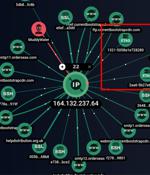Security News

U.K. and U.S. cybersecurity and intelligence agencies have warned of Russian nation-state actors exploiting now-patched flaws in networking equipment from Cisco to conduct reconnaissance and deploy malware against targets. The activity has been attributed to a threat actor tracked as APT28, which is also known as Fancy Bear, Forest Blizzard, FROZENLAKE, and Sofacy, and is affiliated with the Russian General Staff Main Intelligence Directorate.

An Iranian government-backed actor known as Mint Sandstorm has been linked to attacks aimed at critical infrastructure in the U.S. between late 2021 to mid-2022. Targeted entities consist of seaports, energy companies, transit systems, and a major U.S. utility and gas company.

The US, UK, and Cisco are warning of Russian state-sponsored APT28 hackers deploying a custom malware named 'Jaguar Tooth' on Cisco IOS routers, allowing unauthenticated access to the device. A joint report released today by the UK National Cyber Security Centre, US Cybersecurity and Infrastructure Security Agency, the NSA, and the FBI details how the APT28 hackers have been exploiting an old SNMP flaw on Cisco IOS routers to deploy a custom malware named 'Jaguar Tooth.

Microsoft has discovered that an Iranian hacking group known as 'Mint Sandstorm' is conducting cyberattacks on US critical infrastructure in what is believed to be retaliation for recent attacks on Iran's infrastructure. In a new report, researchers in Microsoft's Threat Intelligence team explain that a subgroup of Mint Sandstorm switched from performing surveillance in 2022 to performing direct attacks on US critical infrastructure.

The Iranian threat actor known as MuddyWater is continuing its time-tested tradition of relying on legitimate remote administration tools to commandeer targeted systems. While the nation-state group has previously employed ScreenConnect, RemoteUtilities, and Syncro, a new analysis from Group-IB has revealed the adversary's use of the SimpleHelp remote support software in June 2022.

The Chinese state-sponsored hacking group APT41 was found abusing the GC2 red teaming tool in data theft attacks against a Taiwanese media and an Italian job search company. In Google's April 2023 Threat Horizons Report, released last Friday, security researchers in its Threat Analysis Group revealed that APT41 was abusing the GC2 red teaming tool in attacks.

Security researchers are warning that cybercriminals are increasingly using the Action1 remote access software for persistence on compromised networks and to execute commands, scripts, and binaries. Kostas, a member of the volunteer analyst group The DFIR Report, noticed the Action1 RMM platform being abused by multiple threat actors for reconnaissance activity and to execute code with system privileges on network hosts.

The Russia-linked APT29 threat actor has been attributed to an ongoing cyber espionage campaign targeting foreign ministries and diplomatic entities located in NATO member states, the European Union, and Africa. Nobelium's operations have been attributed to Russia's Foreign Intelligence Service, an organization that's tasked with protecting "Individuals, society, and the state from foreign threats."

Poland's Military Counterintelligence Service and its Computer Emergency Response Team have linked APT29 state-sponsored hackers, part of the Russian government's Foreign Intelligence Service, to widespread attacks targeting NATO and European Union countries. The attackers have targeted diplomatic personnel using spear phishing emails impersonating European countries' embassies with links to malicious websites or attachments designed to deploy malware via ISO, IMG, and ZIP files.

The Transparent Tribe threat actor has been linked to a set of weaponized Microsoft Office documents in attacks targeting the Indian education sector using a continuously maintained piece of malware called Crimson RAT. While the suspected Pakistan-based threat group is known to target military and government entities in the country, the activities have since expanded to include the education vertical. Last month, ESET attributed Transparent Tribe to a cyber espionage campaign aimed at infecting Indian and Pakistani Android users with a backdoor called CapraRAT. An analysis of Crimson RAT samples has revealed the presence of the word "Wibemax," corroborating a previous report from Fortinet.